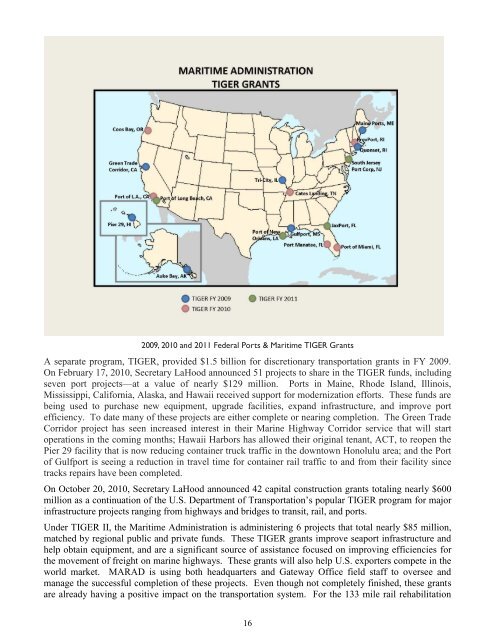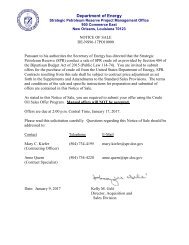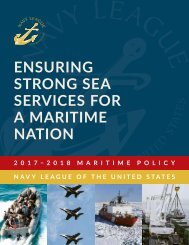2010-11_ANNUAL_REPORTS_-_FINAL_VERSION_(3)
2010-11_ANNUAL_REPORTS_-_FINAL_VERSION_(3)
2010-11_ANNUAL_REPORTS_-_FINAL_VERSION_(3)
Create successful ePaper yourself
Turn your PDF publications into a flip-book with our unique Google optimized e-Paper software.
2009, <strong>2010</strong> and 20<strong>11</strong> Federal Ports & Maritime TIGER Grants<br />
A separate program, TIGER, provided $1.5 billion for discretionary transportation grants in FY 2009.<br />
On February 17, <strong>2010</strong>, Secretary LaHood announced 51 projects to share in the TIGER funds, including<br />
seven port projects—at a value of nearly $129 million. Ports in Maine, Rhode Island, Illinois,<br />
Mississippi, California, Alaska, and Hawaii received support for modernization efforts. These funds are<br />
being used to purchase new equipment, upgrade facilities, expand infrastructure, and improve port<br />
efficiency. To date many of these projects are either complete or nearing completion. The Green Trade<br />
Corridor project has seen increased interest in their Marine Highway Corridor service that will start<br />
operations in the coming months; Hawaii Harbors has allowed their original tenant, ACT, to reopen the<br />
Pier 29 facility that is now reducing container truck traffic in the downtown Honolulu area; and the Port<br />
of Gulfport is seeing a reduction in travel time for container rail traffic to and from their facility since<br />
tracks repairs have been completed.<br />
On October 20, <strong>2010</strong>, Secretary LaHood announced 42 capital construction grants totaling nearly $600<br />
million as a continuation of the U.S. Department of Transportation’s popular TIGER program for major<br />
infrastructure projects ranging from highways and bridges to transit, rail, and ports.<br />
Under TIGER II, the Maritime Administration is administering 6 projects that total nearly $85 million,<br />
matched by regional public and private funds. These TIGER grants improve seaport infrastructure and<br />
help obtain equipment, and are a significant source of assistance focused on improving efficiencies for<br />
the movement of freight on marine highways. These grants will also help U.S. exporters compete in the<br />
world market. MARAD is using both headquarters and Gateway Office field staff to oversee and<br />
manage the successful completion of these projects. Even though not completely finished, these grants<br />
are already having a positive impact on the transportation system. For the 133 mile rail rehabilitation<br />
16




